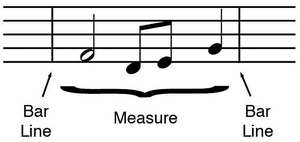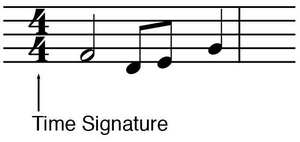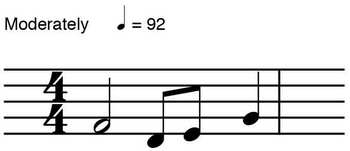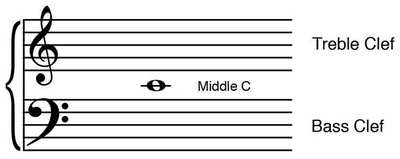Basic Music Theory
An Introduction To Music Theory
In order to read standard music notation, you need a few definitions of basic music theory. The basic components of which are: Notes (pitch and duration); Time Signature; Tempo; and the Staff Clefs.
Notes: Pitch & Duration
All music is composed of notes, created by one or more instruments. Properly tuned instruments create notes of standard pitches in a variety of standard durations. What is pitch? Why are standards needed? How do you know that you are meeting the standards? What are the standard durations? Basic Music Theory explains it all.
Standard Pitches
Pitch is the audible frequency of a sound. For musical instruments, frequencies are created by vibrating air: a reed in a saxophone, a drum-head, or a string on a guitar create the vibrations. Pitch is measured in Hz (hertz), the number of times a vibration repeats itself each second.
Standardized pitches are needed to accurately reproduce songs. Standardized pitches are basic music theory components that allow multiple instruments can play together and create pleasing sounds.
In Western music, the distance from one pitch to another is a half-step, or one semi-tone. (You need to know this for basic music theory, and for chord theory.) Each pitch is identified by a note name, such as C, C# (C-sharp), D, D#, etc. You also need to know the octave that contains the note. An octave is a set of 12 semi-tones. The pitches for the octave are identified in sheet music, by the keys on a keyboard, or the frets on a guitar.
The pitch known as "Concert A" became standardized at 440Hz in 1960. This tone can now be produced and detected by electronic tuners around the world to create the same note. If you have a piano, this note is the A immediately above middle-C. On a guitar, this is the A at the fifth fret of the high-e string... IF your guitar is in tune.
(You can ensure that your guitar is in tune by using a chromatic tuner. Then come back here to read more about basic music theory.)
The Concert-A pitch is one way for music groups of all sizes, from duos to orchestras, to ensure they are in tune with each other.
Concert-A is not the only standardized pitch. In fact, all pitches are now standardized. So, if you are in tune and play C# on the fourth-fret of your A-string, it sounds the same as someone across the country who also plays C# on the fourth-fret of their A-string.
The Tune Your Guitar page lists the standard frequencies for each open string of a six-string guitar (for standard tuning).
Standard Durations
I said earlier that all music is composed of notes, created by one or more instruments. The Standard Pitches section explained how to ensure that all of the instruments produce standardized notes for a pleasing sound. The only missing part, for us to perform a song, is a set of standard note durations.
Standard note durations tell how long the sound is heard.
Some of the symbols for standard durations are:

From left to right:
- Whole Note:
- Is held for four beats in standard (4/4) time. It is equal to two half-notes.
- Half Note:
- Equals two quarter notes.
- Quarter Note:
- Equals two eighth notes.
- Eighth Note:
- Equals two sixteenth notes.
- Sixteenth Note:
- Equals two thirty-second notes.
As you can see, each notation is equal to half the previous one: so, a half-note is held one-half as long as a whole note, a quarter note is held one-half as long as a half-note, and so on. See how easy that is? Basic music theory can also be easy!
Each can be increased by half it's value by adding a dot. For example, a normal half-note is worth two beats; but a dotted half-note is worth three.
How long you actually hold each duration is determined by the time-signature and the tempo of the song.
Time Signature
Another key term for understanding basic music theory is Time Signature. Time Signature identifies which type of note gets one beat, and how many beats are in a measure.
A measure is a container for beats. A bar line is used at the end of a measure.
Here's what a measure might look like:

However, without a time signature, we don't know which type of note gets one beat. We can't count off the notes yet.
Time Signature's are written as two numbers, one above the other (like a fraction). The top number indicates how many beats are in a measure. The bottom number tells you the type of note that receives one beat. For example, the most common time signature, 4/4, has four beats per measure; and the quarter note receives one beat. Here's an example:

Since the quarter note gets one beat (defined by the lower 4), and the measure has four beats (defined by the upper 4), we can now count the beats in this measure. The half-note gets two beats ("1 - 2"); the eighth notes get one beat, split into two counts ("3-and"); and the quarter note gets one beat ("4"). Count this measure "1-2 3-and four"
But, how fast do you count? That's defined by the song's tempo... the next component of basic music theory for you.
Tempo
The rate at which you count off the beats in a measure is called tempo. It is usually measured in beats-per-minute.
When you look at modern sheet music, the tempo may be described with terms like slow, moderately, or fast. Often, the BPM (beats-per-minute) recommended is also give. You may see something like:

In this example, the recommended tempo, 96 BPM is described as a "moderate" pace.
In classical music, you're more likely to see basic music theory terms such as:
- Adagio
- Slowly
- Allegro
- Fast... Lively
- Moderato
- Moderately
- Presto
- Fast
- Prestisimo
- As fast as possible
A Classical Guitar instruction book, or music theory book will list more.
If you're not sure how fast 48-BPM, or 110-BPM are, use a metronome. You should have one even if you do know, to ensure that you keep a steady beat while practicing.
Now you know the count, the duration, and the speed of the notes... but what are the notes? For that, you need to know which Clef you're looking at.
Staff Clefs
Music is written for many instruments, capable of producing a very wide range of frequencies. A typical concert piano, for example, has a range of seven octaves. The lowest note is known as A0, at 27.5 Hz; the highest note is C8 at 4186 Hz. Lower and higher frequencies are possible with other instruments, but are used infrequently.
To identify each note of such a wide range, composers use the Grand Staff. The Grand Staff consists of two staff lines, with additional ledger lines to show lines above or below each staff. The upper set of staff lines are known as the Treble Staff and is identified by the Treble Clef; the lower set is known as the Bass Staff and is identified by the Bass Clef. Here's an example to make this basic music theory item clear:

Now, finally, we can identify the notes in our measure of music used in the Tempo and Time Signature sections... they are: F (half-note), D - E (eighth notes), and G (quarter note).
The Bottom Line...
Combining standard notes... standard durations... at a particular tempo... with a particular time signature... allows musicians to write music for others and perform music we've never heard before.
Learn More!
Ready to learn more? Pick up a copy of Sandy Feldstein's Practical Theory Complete. Now available in a consolidated edition, this self-taught course on basic music theory explains many topics with worksheets and self-check answers.


